Latin America Passenger Car Market Size
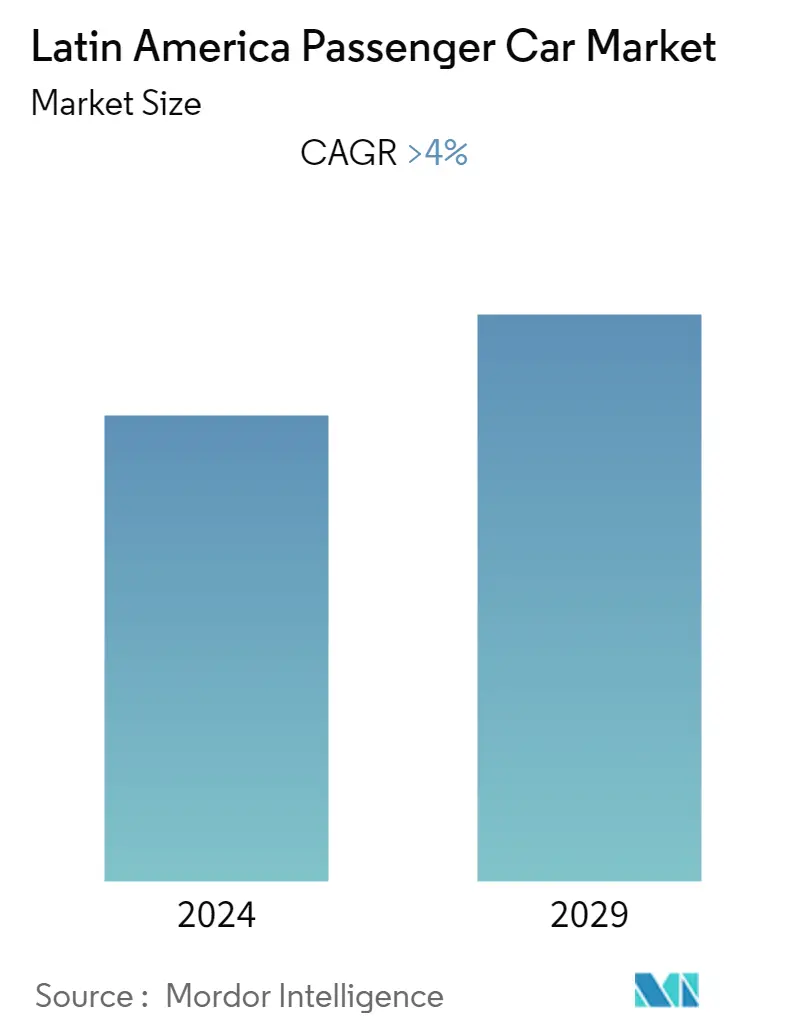
| Study Period | 2020 - 2029 |
| Base Year For Estimation | 2023 |
| Forecast Data Period | 2024 - 2029 |
| Historical Data Period | 2020 - 2022 |
| CAGR | 4.00 % |
| Market Concentration | High |
Major Players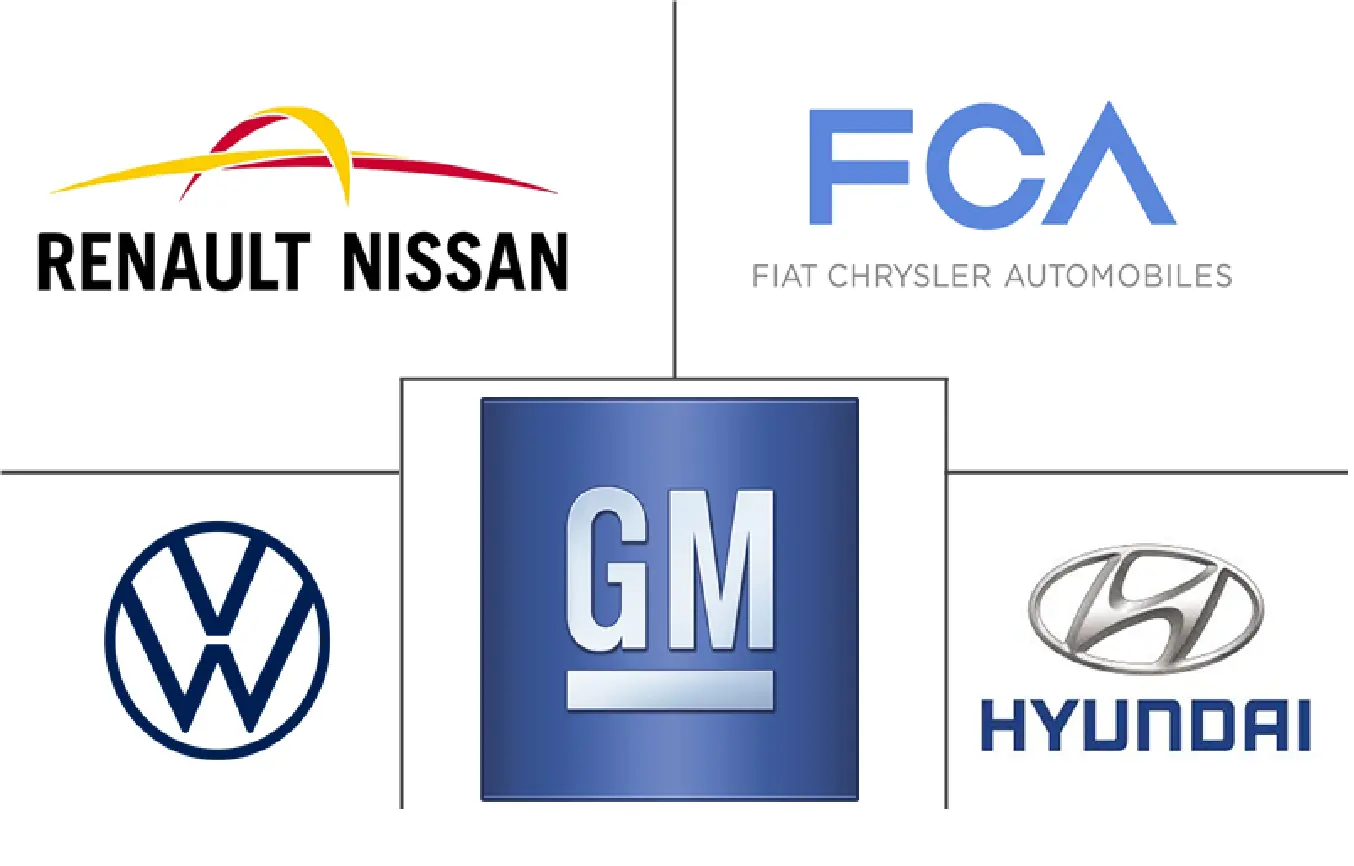
*Disclaimer: Major Players sorted in no particular order |
Latin America Passenger Car Market Analysis
Currently, the Latin America Passenger Car Market is valued at USD 129.14 billion, and it is expected to reach USD 161.74 billion in the next five years at a CAGR of 4.61% during the forecast period.
The Latin American passenger car market is recovering at a steady pace after most of the countries were strongly affected by currency deviation, economic crisis, and COVID-19. The overall passenger car market was boosted by the Mexican market, which accounts for the major market share in terms of exports, production, and sales.
The Latin American market slowly recovered from the pandemic, with an overall market of 2.21 million vehicles in H1 2021. Although it continues to have an impact on the region's economies, the vehicle market saw a 35% increase in sales compared to the first half of last year. Stellaris was able to lead and capture a 20% market share in this environment.
In terms of unit sales, Brazil is by far the largest market for passenger cars in Latin America. More than 1.5 million cars were expected to be sold in Brazil last year. Mexico came in second, with approximately 520,110 thousand cars sold last year.
- With the increasing penetration of the internet and smartphones in the Latin American (LATAM) region, OEMs are finding innovative ways to connect with consumers and are focusing on offering e-commerce platforms and new service models. E-commerce is expected to have a significant positive impact on the automotive aftermarket. This leads to the optimization of services and growth in the sales of automotive parts. For instance, in October 2022, BYD, the leading Chinese new energy vehicle (NEV) manufacturer, formed a partnership with Saga Group, Brazil's largest dealer group, and their first cooperative store opened in Brasilia, Brazil's capital.
Latin America Passenger Car Market Trends
This section covers the major market trends shaping the Latin America Passenger Car Market according to our research experts:
Zero Emission Vehicles Gaining Traction in Latin America
Although the passenger car industry in Latin America is dominated by gasoline, ethanol-driven cars recorded good sales during the last three years.
Electric vehicles (EVs4) are being adopted in some Latin American passenger car markets. Due to their larger market sizes, Mexico and Brazil have higher EV sales but lower market shares. Among Latin American countries, Mexico is the only ZEVTC member. In Latin America, as in other developing regions, electric passenger car adoption is still in its early stages. Major EV players are trying to enter the market in Brazil.
For instance, in November 2022, BYD Co. Ltd, a Chinese automaker, announced that it would begin selling two new electric vehicle models in Brazil, banking on positive political and environmental developments in Latin America's largest vehicle market.
International financial agencies and development organizations such as the Global Environment Facility (GEF), the United Nations (UN), the National Finance Corporation (CFN), the Central American Bank for Economic Integration, and the European Union have provided financial and technical assistance to Latin American countries for ZEV transitions. Over the last five years, these organizations have provided non-profit funding of USD 7.4 million and a loan of USD 7.6 million to at least six countries for technical and financial feasibility studies of electric vehicles, fleet deployment, and policy interventions and demonstration projects. Non-profit funding ranges from USD 40,000 to USD 2.4 million per country, depending on the area of intervention.
- The current level of international support falls far short of what is required to enable non-ZEVTC countries in the region to leapfrog to ZEVs. A five-year goal of increasing cumulative ZEV sales to 10% of 2020 passenger vehicle, bus, and 2 and 3-wheeler sales would necessitate funding at a rate of USD 30 per kWh11 of battery capacity, or approximately USD 1.1 billion. This is a rough estimate, but it demonstrates the disparity between existing and needed international assistance. The funding could be used for a variety of purposes, including, but not limited to, technical assistance, policy interventions, R&D, infrastructure, financial incentives, localization of the ZEV value chain, and loan service to help Latin America leapfrog ZEVs.
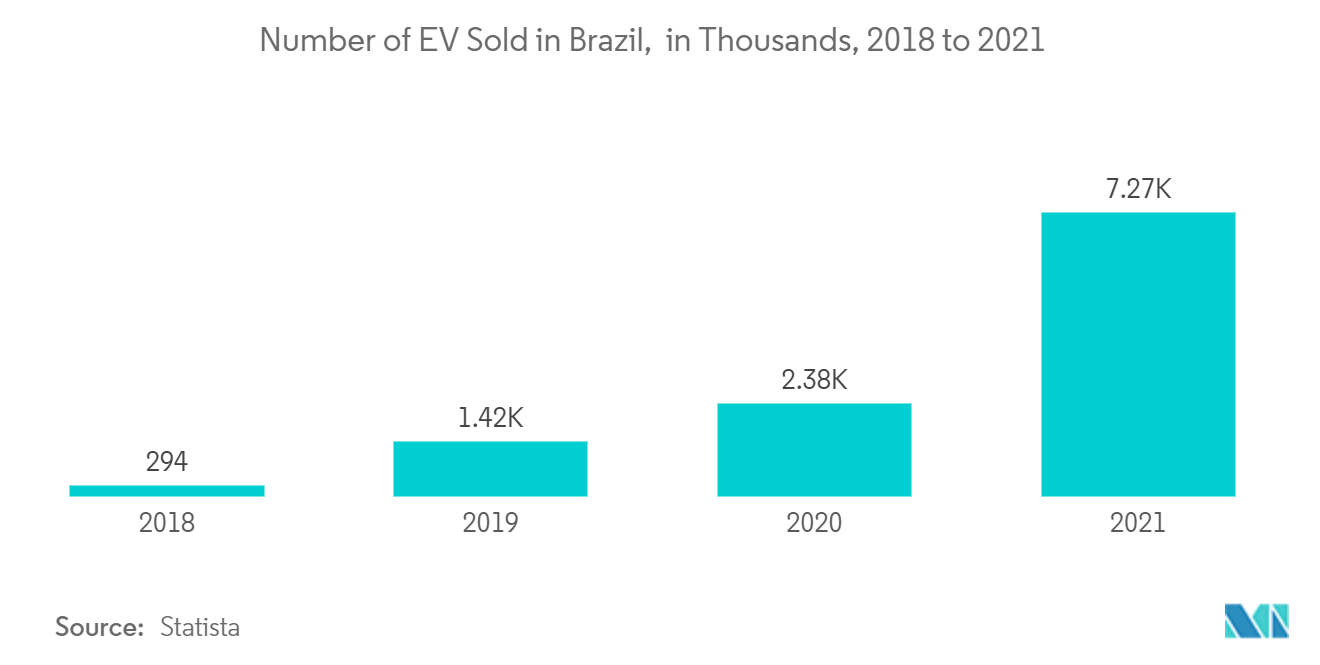
Recovering Automotive Industries in Brazil, Argentina, and Peru
The Latin American market has enormous potential for the automotive industry as car ownership is low in the region, and disposable incomes are growing faster than in the Asia-Pacific region. The automotive industry experienced healthy growth. In terms of unit sales, Brazil was the largest market last year. Mexico came in second, with approximately 520,110 thousand cars sold that year.
Brazil has traditionally used protectionist policies as part of its Inovar Auto Policy to protect domestic automakers from imports by offering tax breaks and other incentives. However, the policy's impact was boosted by increased domestic competitiveness and a decrease in imports. The policy made no provision for export promotion, which harmed the industry when domestic demand fell.
- Moreover, major players are indulging in collaboration with finance companies in Brazil to provide financial support to the customers and support the growth of the market in the coming years. For instance, in October 2022, BYD, the Chinese new energy vehicle and battery giant, formally signed a strategic cooperation agreement with Santander's Brazilian division, a domestic auto finance industry leader.
Argentina is the Brazilian auto industry's largest export market, but sales have dropped due to the Argentine economy's downturn. In September 2019, Brazil and Argentina renewed their auto trade agreement, allowing increased Brazilian exports to its neighbor through 2029 but postponing free trade in motor vehicles for the next decade.
Furthermore, Peru has experienced rapid economic growth over the last five years and is poised to become one of Latin America's leading automotive players. This is due to factors such as Peru's open market strategy, which has resulted in the establishment of new free trade agreements (FTAs) with Asian countries, the Association of Southeast Asian Nations (ASEAN), and North America.
- Several major automakers, including General Motors, Subaru, and Land Rover, have made investments in the Latin American market. Furthermore, with the implementation of new vehicle tax breaks, automobile sales are expected to skyrocket.
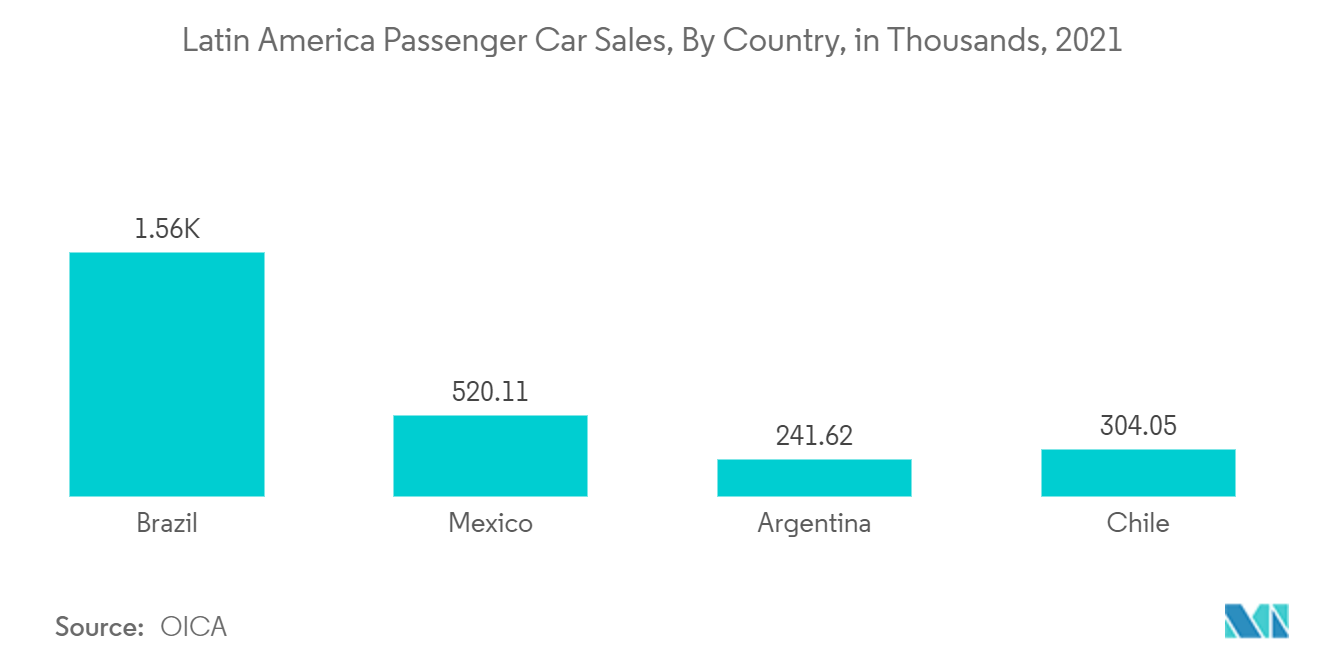
Latin America Passenger Car Industry Overview
Some of the major manufacturers in the market include Nissan-Renault, General Motors, Volkswagen AG, FCA Group, Hyundai-Kia, Toyota Motor Corporation, and Ford. Further ongoing plant expansion, mergers, and acquisitions between the vehicle manufacturer are witnessing major market growth.
For instance, in November 2022, BYD signed a letter of intent with the State of Bahia to take over Ford's Camaçari plant facility in order to establish three new assembly lines. The government claims that BYD would invest BRL 3 billion to produce fully electric buses, trucks, and passenger cars in addition to electric and hybrid vehicles and a unit for processing lithium and iron phosphate. Additionally, in July 2022, Hyundai announced a BRL 200 million investment in the Piracicaba plant in Brazil to renew its HB20 compact range, just as the hatchback is becoming the country's best-selling passenger car.
Latin America Passenger Car Market Leaders
-
Renault-Nissan
-
General Motors Company
-
Volkswagen AG
-
FCA Group
-
Hyundai Motor Company
*Disclaimer: Major Players sorted in no particular order
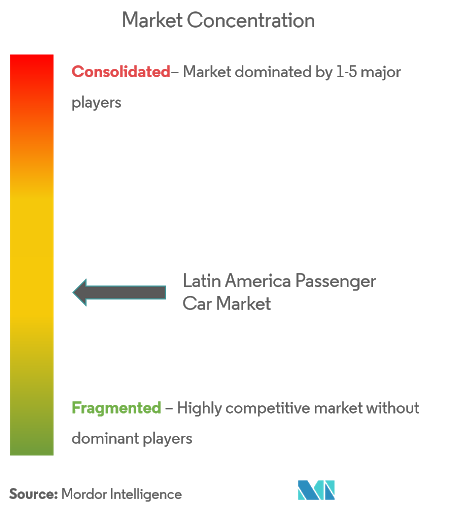
Latin America Passenger Car Market News
- Nov 2022: Great Wall Motors (GWM) announced that it will begin selling the Haval H6 SUV in Brazil in the first quarter of 2023, with a package of semi-autonomous features and safety technologies, including facial recognition, which can identify up to five different people registered in the system.
- Oct 2022: Toyota stated that it would introduce the "Conquest," a new model of the Toyota Hilux made in Argentina. The number of pickup models produced at Zárate will rise from 15 to 16 with the Conquest's anticipated debut. Although it will be more affordable and have less power than the Hilux GR-Sport III, the Hilux Conquest will have a distinctive look and unique features and be focused on off-road and recreational use.
- Jan 2022: Link, an electric vehicle manufacturer in the US, planned to set up its assembly plant in the Mexican state of Puebla. This production setup received an investment of USD 265 million.
Latin America Passenger Car Market Report - Table of Contents
1. INTRODUCTION
- 1.1 Study Assumptions
- 1.2 Scope of the Study
2. RESEARCH METHODOLOGY
3. EXECUTIVE SUMMARY
4. MARKET DYNAMICS
- 4.1 Market Drivers
- 4.2 Market Restraints
-
4.3 Industry Attractiveness - Porter's Five Forces Analysis
- 4.3.1 Threat of New Entrants
- 4.3.2 Bargaining Power of Buyers/Consumers
- 4.3.3 Bargaining Power of Suppliers
- 4.3.4 Threat of Substitute Products
- 4.3.5 Intensity of Competitive Rivalry
5. MARKET SEGMENTATION (Market Size in USD Billion)
-
5.1 By Vehicle Type
- 5.1.1 Hatchback
- 5.1.2 Sedan
- 5.1.3 Sports Utility Vehicle
-
5.2 By Fuel Type
- 5.2.1 Gasoline
- 5.2.2 Diesel
- 5.2.3 Electric
-
5.3 By Geography
- 5.3.1 Latin America
- 5.3.1.1 Brazil
- 5.3.1.2 Argentina
- 5.3.1.3 Mexico
- 5.3.1.4 Rest of Latin America
6. COMPETITIVE LANDSCAPE
- 6.1 Vendor Market Share
-
6.2 Company Profiles
- 6.2.1 General Motors
- 6.2.2 Fiat Chrysler Automobiles (FCA)
- 6.2.3 Volkswagen AG
- 6.2.4 Hyundai Motor Company
- 6.2.5 Ford Motor Company
- 6.2.6 Toyota Motor Corporation
- 6.2.7 Renault
- 6.2.8 Honda Motor Co. Ltd
- 6.2.9 Nissan Motor Corporation
- 6.2.10 Suzuki Motor Corporation
- 6.2.11 Daimler AG (Mercedes-Benz)
- 6.2.12 BMW
- 6.2.13 Audi
- *List Not Exhaustive
7. MARKET OPPORTUNITIES AND FUTURE TRENDS
** Subject To AvailablityLatin America Passenger Car Industry Segmentation
A passenger car is a road motor vehicle, other than a moped or a motorcycle, designed to transport passengers and seat no more than nine people.
The Latin American Passenger Car Market is segmented by Vehicle Type (Hatchback, Sedan, and Sports Utility Vehicle), Fuel Type (Gasoline, Diesel, and Electric), and Country (Brazil, Argentina, Mexico, and the Rest of Latin America). The report provides market size in value (USD) for all mentioned segments.
| By Vehicle Type | Hatchback | |
| Sedan | ||
| Sports Utility Vehicle | ||
| By Fuel Type | Gasoline | |
| Diesel | ||
| Electric | ||
| By Geography | Latin America | Brazil |
| Argentina | ||
| Mexico | ||
| Rest of Latin America |
Latin America Passenger Car Market Research FAQs
What is the current Latin America Passenger Car Market size?
The Latin America Passenger Car Market is projected to register a CAGR of greater than 4% during the forecast period (2024-2029)
Who are the key players in Latin America Passenger Car Market?
Renault-Nissan, General Motors Company, Volkswagen AG, FCA Group and Hyundai Motor Company are the major companies operating in the Latin America Passenger Car Market.
What years does this Latin America Passenger Car Market cover?
The report covers the Latin America Passenger Car Market historical market size for years: 2020, 2021, 2022 and 2023. The report also forecasts the Latin America Passenger Car Market size for years: 2024, 2025, 2026, 2027, 2028 and 2029.
Latin America Passenger Car Industry Report
Statistics for the 2024 Latin America Passenger Car market share, size and revenue growth rate, created by Mordor Intelligence™ Industry Reports. Latin America Passenger Car analysis includes a market forecast outlook to 2029 and historical overview. Get a sample of this industry analysis as a free report PDF download.



